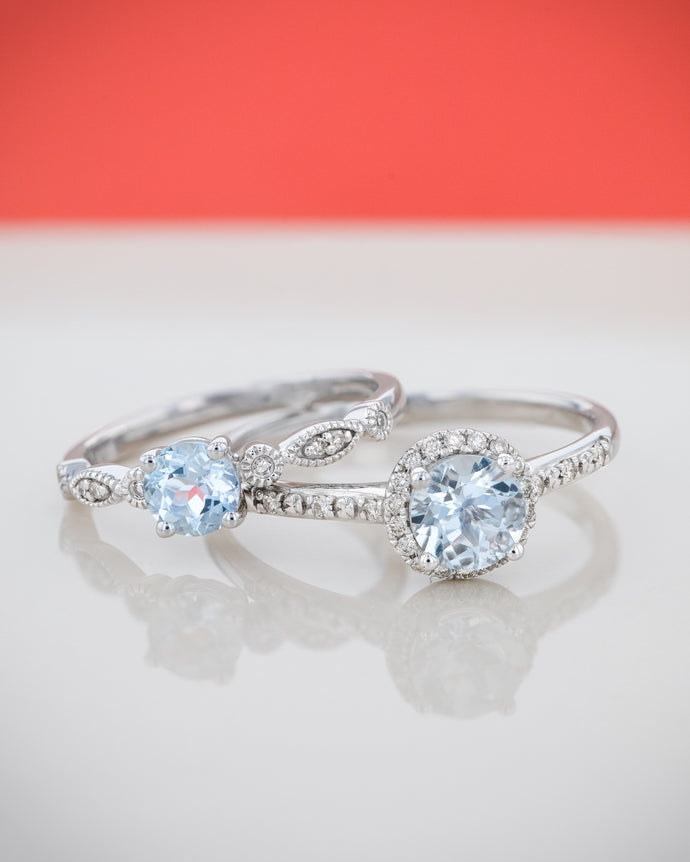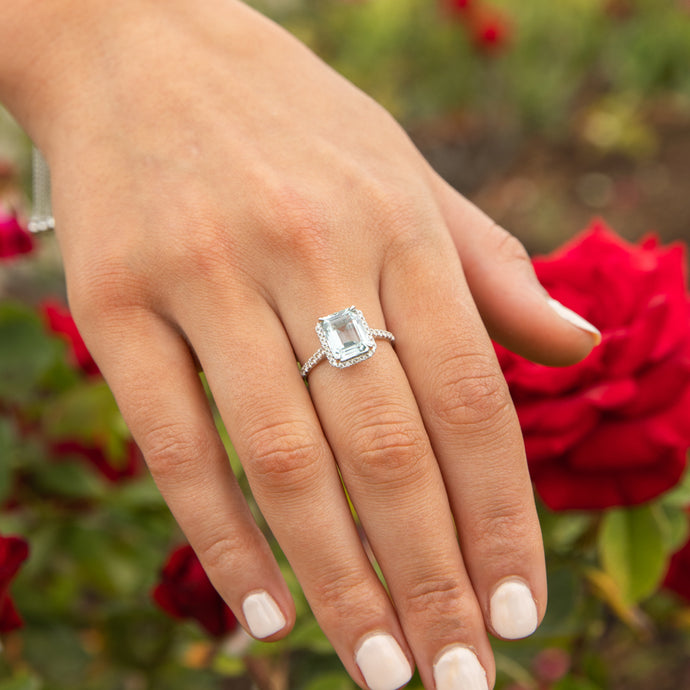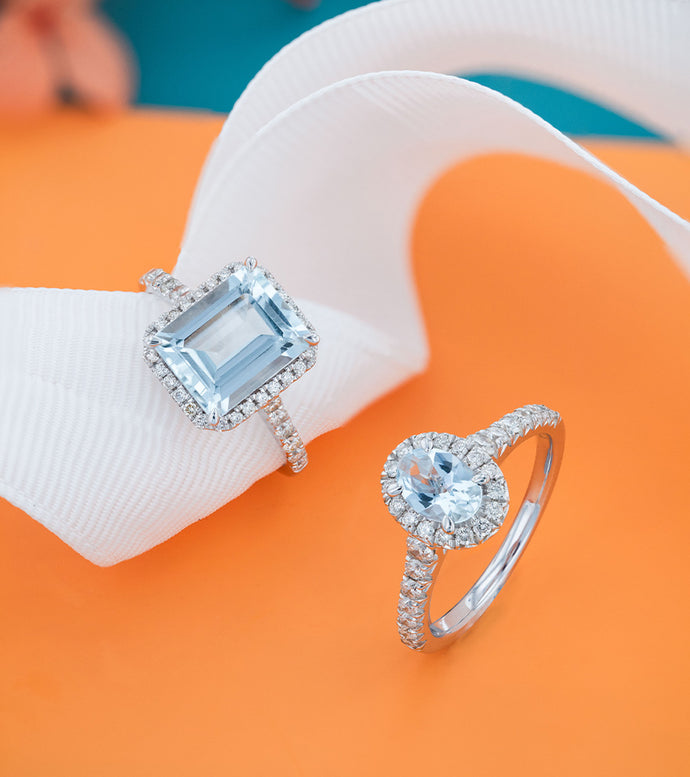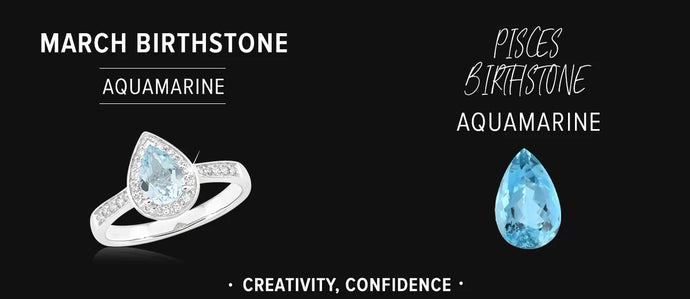March Birthstone
The March birthstone or more fittingly, birthstones are the bloodstone and aquamarine. The Bloodstone is seen as the more traditional birthstone, while an Aquamarine is seen as the more modern version. Arguably, the most popular of the two, an aquamarine is the birthstone that is more commonly associated with March.
With a beautiful light-blue hue that is reminiscent of the crystal-clear waters at some of the most scenic beaches in the world, it’s not difficult to see why March babies can’t seem to go past this enchanting stone.
Read on to learn all about the March birthstone and to browse some beautiful March Aquamarine jewellery.
Overview of the March birthstone:
- Meaning & compounds of Aquamarine stones
- History of Aquamarine stones
- Where are Aquamarine stones found?
- Our favourite Aquamarine jewellery

THE MEANING AND PHYSICAL COMPOUNDS OF AQUAMARINE STONES
Derived from the Latin word for seawater, there are many myths and legends associated with Aquamarine stones. One of the eldest legends surrounding these illuminating stones dates to Ancient Rome, where they believe if a frog was carved onto an Aquamarine stone it would turn enemies into friends. During this period, Aquamarine stones were also known as sailor’s gems as it was believed they ensured a safe and prosperous journey across stormy seas.
The Egyptians, Hebrews and Sumerians believed that Aquamarine stones were a symbol of happiness and everlasting youth, while some also believed that Aquamarine stones would help locate lost items. According to folklore, Aquamarine stones were even believed to bring victory in battles and legal disputes while also being a unique method to combat belching and yawning.
A soothing stone, Aquamarine is also used in crystal healing as it is believed to help cure phobias and irrational fears. It is thought to be a stone that adds to your overall sense of wellbeing that will also help you to stop procrastinating...maybe we all need a little aquamarine in our lives to help us have a more productive day at work.
Varying in colour from deep blue to blue-green, the March birthstone is completely composed of the mineral Beryl. Often regarded as a “poor man’s diamond” due to its likeness to the king of the gems, Aquamarines measure in at 7.5-8 on the Mohs scale of mineral hardness. This makes Aquamarine stones only slightly less durable than diamonds, which measure 10 on the Mohs hardness scale.

THE HISTORY OF THE MARCH BIRTHSTONE
The first documented use for Aquamarine stones was in Ancient Greece where they wore Aquamarine amulets engraved with Poseidon (the Greek God of the sea) sitting on a chariot. The Greeks and Romans attributed their existence to God and believed that the stones harboured medicinal properties that would help relieve ailments affecting the stomach, liver, throat and jaws. They also believed that Aquamarine stones would be an effective anecdote for poisonings.
The fascination with this decadent ocean-blue stone would continue right through to the 17th century, where it gained tremendous popularity with the people living at the time. Aquamarine stones were even part of the Czech Crown Jewels during the reign of the Bohemia Royal Family in the Kingdom of Bohemia, which is now known as the Czechoslovak Republic.
Today, Aquamarine jewellery is admired by some of the most famous faces in the world, including modern-day royals. Most recently, the Duchess of Sussex, Meghan Markle sported a stunning Aquamarine ring that was once owned by Diana, the Princess of Wales at her wedding to Prince Harry. And she’s not the only member of the British Royal Family to rock some Aquamarine jewellery, Queen Elizabeth II was famously gifted a priceless tiara featuring the stone by the Brazillian government as a coronation present. Australia’s own princess, Mary of Denmark has even been spotted wearing some glamorous Aquamarine earrings.

WHERE ARE AQUAMARINE STONES FOUND?
Aquamarine stones were first discovered by miners in 1723 in the Adun-Chalon Mountains of Siberia. This site quickly became the number one site to retrieve these brilliant blue gemstones. Other locations where Aquamarine stones are commonly found include the United States, Sri Lanka, India, Zambia, Russia, Tanzania, Nigeria, Pakistan, Mozambique, Kenya, Malawi, Afghanistan, Kenya as well as Brazil which is considered to be the Aquamarine stone capital of the world.
As the leading source for Aquamarine stones, Brazil is responsible for a majority of Aquamarine stones in circulation today. The site responsible for producing a majority of the stones is a mine located in the Marambaia Valley region. This area has produced some of the largest Aquamarine stones known to man. One near-perfect stone found in the mine during the early 1900s weighed a whopping 500,000 carats, which is the equivalent of 110 kilograms. Other monstrous stones found in the area were the Marta Rocha Aquamarine which was 173,000 carats (34.6 kilograms) and the Estrela de Alva Aquamarine which was 96,000 carats (19.2 kilograms)

OUR FAVOURITE AQUAMARINE JEWELLERY
At Shiels, we have some exquisite Aquamarine jewellery in stones that range from a light-ocean blue to a blue-green hue. In the collection, you’ll find gemstones in all kinds of jewellery forms including Aquamarine Pendants,Aquamarine necklaces and Aquamarine chains. Enjoy the March birthstone!










































